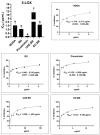Boesenbergia rotunda and Its Pinostrobin for Atopic Dermatitis: Dual 5-Lipoxygenase and Cyclooxygenase-2 Inhibitor and Its Mechanistic Study through Steady-State Kinetics and Molecular Modeling
- PMID: 38247498
- PMCID: PMC10812521
- DOI: 10.3390/antiox13010074
Boesenbergia rotunda and Its Pinostrobin for Atopic Dermatitis: Dual 5-Lipoxygenase and Cyclooxygenase-2 Inhibitor and Its Mechanistic Study through Steady-State Kinetics and Molecular Modeling
Abstract
Human 5-lipoxygenase (5-LOX) and cyclooxygenase-2 (COX-2) are potential targets for suppressing pruritic skin inflammation in atopic dermatitis (AD). In addition, Staphylococcus aureus colonization and oxidative stress worsen AD skin conditions. We aimed to investigate anti-inflammatory activity, using 5-LOX and COX-2 inhibitions, and the anti-staphylococcal, and antioxidant potentials of several medicinal plants bio-prospected from traditional medicine related to AD pathogenesis. Essential oils and hexane fractions were prepared and analyzed using gas chromatography-mass spectrometry. Boesenbergia rotunda hexane extract displayed anti-Staphylococcus aureus (MIC = 10 µg/mL) and antioxidant activities (IC50 = 557.97 and 2651.67 µg/mL against DPPH and NO radicals, respectively). A major flavonoid, pinostrobin, was further nonchromatographically isolated. Pinostrobin was shown to be a potent 5-LOX inhibitor (IC50 = 0.499 µM) compared to nordihydroguaiaretic acid (NDGA; IC50 = 5.020 µM) and betamethasone dipropionate (BD; IC50 = 2.077 µM) as the first-line of AD treatment. Additionally, pinostrobin inhibited COX-2 (IC50 = 285.67 µM), which was as effective as diclofenac sodium (IC50 = 290.35 µM) and BD (IC50 = 240.09 µM). This kinetic study and molecular modeling showed the mixed-type inhibition of NDGA and pinostrobin against 5-LOX. This study suggests that B. rotunda and its bioactive pinostrobin have promising properties for AD therapy.
Keywords: GC–MS; anti-inflammatory; antibacterial; antioxidant; fingerroot; flavonoid.
Conflict of interest statement
The authors declare no conflicts of interest.
Figures






Similar articles
-
Enhanced Anti-Inflammatory and Skin Barrier Repair Effects of Nanoemulsions Supplemented with Boesenbergia rotunda for Atopic Dermatitis.ACS Nanosci Au. 2024 Dec 2;5(1):37-51. doi: 10.1021/acsnanoscienceau.4c00053. eCollection 2025 Feb 19. ACS Nanosci Au. 2024. PMID: 39990109 Free PMC article.
-
Pinostrobin: An Adipogenic Suppressor from Fingerroot (Boesenbergia rotunda) and Its Possible Mechanisms.Foods. 2022 Sep 29;11(19):3024. doi: 10.3390/foods11193024. Foods. 2022. PMID: 36230099 Free PMC article.
-
The methanolic extract of Boesenbergia rotunda (L.) Mansf. and its major compound pinostrobin induces anti-ulcerogenic property in vivo: possible involvement of indirect antioxidant action.J Ethnopharmacol. 2011 Sep 2;137(2):963-70. doi: 10.1016/j.jep.2011.07.010. Epub 2011 Jul 8. J Ethnopharmacol. 2011. PMID: 21771650
-
Fingerroot, Boesenbergia rotunda and its Aphrodisiac Activity.Pharmacogn Rev. 2017 Jan-Jun;11(21):27-30. doi: 10.4103/phrev.phrev_50_16. Pharmacogn Rev. 2017. PMID: 28503050 Free PMC article. Review.
-
Toward the use of Boesenbergia rotunda extracts and the chalcone panduratin A to treat periodontitis.J Oral Biosci. 2022 Jun;64(2):183-192. doi: 10.1016/j.job.2022.03.002. Epub 2022 Mar 17. J Oral Biosci. 2022. PMID: 35306173 Review.
Cited by
-
Traditional usages, chemical metabolites, pharmacological activities, and pharmacokinetics of Boesenbergia rotunda (L.) Mansf.: a comprehensive review.Front Pharmacol. 2025 Mar 19;16:1527210. doi: 10.3389/fphar.2025.1527210. eCollection 2025. Front Pharmacol. 2025. PMID: 40176912 Free PMC article. Review.
-
Network pharmacology and in silico analysis reveal Kochiae Fructus as a potential therapeutic against atopic dermatitis through immunomodulatory pathway interactions.PLoS One. 2025 Apr 3;20(4):e0320818. doi: 10.1371/journal.pone.0320818. eCollection 2025. PLoS One. 2025. PMID: 40179089 Free PMC article.
-
Enhanced Anti-Inflammatory and Skin Barrier Repair Effects of Nanoemulsions Supplemented with Boesenbergia rotunda for Atopic Dermatitis.ACS Nanosci Au. 2024 Dec 2;5(1):37-51. doi: 10.1021/acsnanoscienceau.4c00053. eCollection 2025 Feb 19. ACS Nanosci Au. 2024. PMID: 39990109 Free PMC article.
-
Simultaneous Determination of Stilbenes, Flavones, Coumestans, Anthraquinones, and Chalcones in Ethanolic Extract of Pet-Sang-Kard Mixed Herbal Remedy Using HPLC-PDA Analysis.Molecules. 2025 Jan 8;30(2):222. doi: 10.3390/molecules30020222. Molecules. 2025. PMID: 39860092 Free PMC article.
-
Efficient Simultaneous Isolation of Pinostrobin and Panduratin A from Boesenbergia rotunda Using Centrifugal Partition Chromatography.Molecules. 2024 Nov 2;29(21):5186. doi: 10.3390/molecules29215186. Molecules. 2024. PMID: 39519827 Free PMC article.
References
Grants and funding
LinkOut - more resources
Full Text Sources
Research Materials
Miscellaneous

